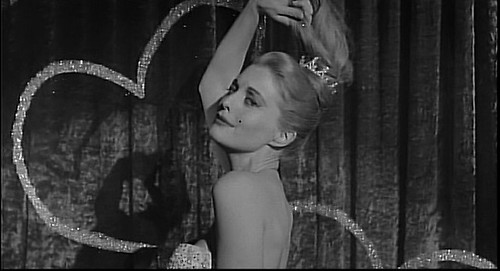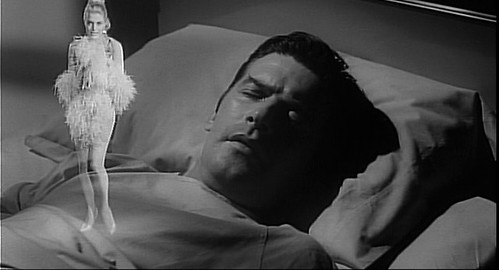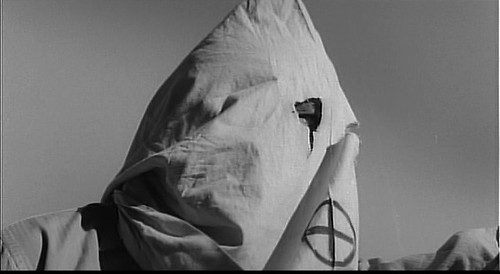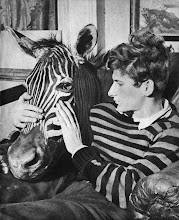Samuel Fuller's foundational work predates the exploitation age, but his in morality-plays-cloaked-in-genre-films we find a precedent for what was to come in both style and social vision. Fuller's sensationalism is charged with the anxiety of the post-WWII/early Cold War period, a creeping panic that the social order is unsound and may give way at any moment to savage chaos.
In 1963's Shock Corridor, the chaos agent in question is the dread science of psychology. The premise is this (and if this ain't a hook, I don't know what is): to solve a murder at a mental institution, overambitious reporter Johnny Barrett (Peter Breck) feigns insanity to be committed to said asylum where he can investigate from the inside. If all goes according to plan, he'll crack the case, get the big scoop, win a Pulitzer, and get back to his burlesque dancer girlfriend Cathy (Constance Towers) in no time at all. Of course, things never go according to plan, and Barrett finds his own sanity in question.

From the outset, the film's attitude toward psychology is supremely skeptical. The discipline as practiced by the doctors is essentially a bureaucratic meat grinder, performing ham-handed diagnoses in broad strokes of pseudo-science mumbo jumbo, guiding patients through a series of absurd and grotesque treatments (dance therapy, hydrotherapy, shock treatment).The primary purpose of the asylum seems to be containment; if there is any rehabilitation going on, we do not see it.
The characters regard psychology with similar dismissal. To Barrett, a fine avatar of the 1950's Let-Men-Be-Men American male archetype, psychology is no more than a gimmick, and his interest owes only to it being "what people buy." His girlfriend's position strikes closer to the film's sensationalistic tenor. "A man can't tamper with the mind!" she proclaims. "Their sickness is bound to rub of onto you!" To Cathy, meddling in the workings of the mind is forbidden, unholy; once the dark waters of the consciousness are stirred, they are liable to come spurting out in a geyser of madness, shattering the ever-so-fragile equilibrium of the personality.

In fact, Shock Corridor takes this notion quite seriously. Beneath the surface skepticism toward psychology and psychoanalysis, we find at the film's heart much more powerful belief. We observe the sway of the subconscious over individuals, and in Barrett's investigations even witness the power of psychoanalysis in practice.
Fuller's madmen seem to share a single syndrome: they have become unstuck from the social continuum and are lost within the spheres of their own desire and trauma. The main setpiece of the film is the sterile white hallway of the asylum where the lunatics are allowed to congregate. To the mad, this blank passage becomes a fantasmal space, a nexus of dream, a bare stage upon which the fantasies of maniacs may be enacted, given cinematic flourish by the score and camera work. Here the Communist defector may become a Confederate hero, the bullied black student may become Grand Wizard of the Ku Klux Klan, the nuclear scientist may become an innocent child.

Barrett's sleuthing consists of integrating himself into the fantasies of the witnesses and attempting to lead them toward moments of sanity during which they may disclose crucial details about the case. The technique, you may observe, is effectively a variation on the talking cure, and indeed it proves successful. In each case, Barrett guides the patient through their fantasies toward moments of cathartic break, represented by the use of color stock footage (the film is in black and white) depicting far away places and cultures. By leading them through a mosaic of personal, cultural, and racial memory, Barrett reconciles the patients with their worlds and their "true" selves, allowing them to offer testimony before slipping once again into madness.
The film also plumbs the complexities of Barrett's own consciousness as his sanity begins to crack; the doctor's diagnosis of the reporter's ostensibly phony ailment ("a culmination of internal sexual conflicts") may not be so far off. At the heart of Barrett's troubles, I claim, is an anxiety regarding his girlfriend's fidelity. Early on in his lockup, she appears to him in a dream, manifesting as a phantasmal siren, sing-songing to him, "You made me be alone, Johnny. And I have the right to find another Johnny." His crisis is one of potency, and it eventually undermines his sense of agency and ego. (This anxiety also emerges in a humorous moment as Barrett wanders into the ward of Maenad-like nymphomaniacs. "Nymphos!" he exclaims to himself with alarm as he is beset by a ring of buxom beauties. Another golden moment in cinema history.)
The film is an equally marvelous viewing at its surface sensual level, filled to the brim with expressive framing and rich, sonorous noir language ("My yen for you goes up and down like a fever chart" is a particular favorite. That's a pretty slick thing to say to your shorty, by the way, so gents take note).
Anyway, thanks for taking a gander at my new blog. I'm going to try to update here once a week, and I'm thinking the next entry will be a look at Ol' Dirty Bastard's "All In Together Now." Stay tuned.




